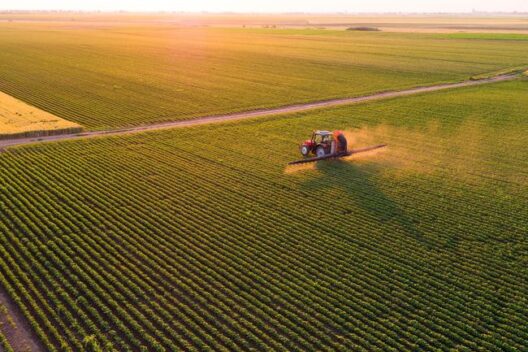The interplay between agriculture and global warming is often underestimated, yet it carries significant implications for our planet’s climatic equilibrium. The “Fertilizer Factor” epitomizes an essential component of this intricate relationship, illuminating the ways in which agricultural practices—particularly the use of fertilizers—contribute to the escalation of greenhouse gas emissions, ostensibly influencing climate change.
The agricultural sector is a pivotal contributor to the global economy, providing sustenance for billions. However, the methodologies employed within this sector can have deleterious effects on the environment. Among the most glaring practices is the use of synthetic fertilizers. These substances, while instrumental in enhancing crop yields, are also at the heart of a complex web of environmental repercussions.
To comprehend the Fertilizer Factor, one must first appreciate the chemical constituents found within these fertilizers. Primarily composed of nitrogen, phosphorus, and potassium, these ingredients accelerate plant growth but may inadvertently release potent greenhouse gases—especially nitrous oxide (N2O)—into the atmosphere. The process is somewhat insidious: when nitrogen compounds from fertilizers are applied to the soil, only a fraction is absorbed by plants. The remainder can undergo denitrification, a microbial process that emits N2O, a gas with a global warming potential that is 298 times greater than carbon dioxide (CO2) over a 100-year period.
Moreover, the sheer volume of fertilizer use is staggering. According to various agronomical sources, the global application of synthetic nitrogen fertilizers has increased nearly fivefold since the 1960s. This exponential growth reflects an elevation in agricultural intensity, aiming to satisfy the ever-increasing demands of a burgeoning population. While these fertilizers enable higher production levels, they also underscore a paradox: increased outputs are not always synonymous with sustainable practices.
The management of fertilizer applications has become a critical focal point in mitigating agricultural contributions to global warming. Surprisingly, improper application techniques substantially exacerbate emissions. Over-fertilization can easily occur, with excess nutrients washed away by rain or irrigation, leaching into waterways and ultimately resulting in eutrophication—an environmental phenomenon leading to harmful algal blooms and “dead zones” in aquatic ecosystems. Ironically, these dead zones further compromise the resilience of our ecosystems and diminish their capacity to sequester carbon, thereby perpetuating the cycle of climate change.
In addressing the over-reliance on synthetic fertilizers, it becomes crucial to examine alternative agricultural practices that are conducive to sustainability. Organic farming, permaculture, and agroecology present viable methods that eschew the heavy use of synthetic inputs. These systems often emphasize biodiversity, crop rotation, and the use of organic compost, which not only fortify soil health but also foster ecosystems capable of adaptation in the face of a warming climate. Such strategies offer the dual benefit of mitigating emissions while simultaneously enhancing agricultural resilience to fluctuating climatic conditions.
Another pressing dimension of fertilizer-related emissions stems from the production processes themselves. The Haber-Bosch process, a method for synthesizing ammonia, epitomizes the energy-intensive nature of fertilizer production. This process is responsible for a significant percentage of global industrial energy consumption and associated CO2 emissions. As nations transition toward renewable energy sources, it is imperative that fertilizer production processes are also scrutinized and modified to mitigate carbon footprints.
Nevertheless, the Fertilizer Factor is not merely about mitigation; it invokes an urgent call to action for policymakers, farmers, and consumers alike. Collaborative efforts to promote sustainable agricultural practices, support research on integrated nutrient management, and incentivize the adoption of organic farming principles should be at the forefront of our climate action agenda. Moreover, innovative technologies such as precision agriculture—a farming management concept that utilizes information technology and big data—holds promise. Through careful monitoring of crop and soil conditions, farmers can optimize fertilizer applications, thereby reducing excess and promoting efficiency.
On an individual level, consumers also wield substantial influence. The choices made at the dinner table reverberate throughout agricultural systems. Opting for locally sourced and organic produce can bolster sustainable farming practices, helping to decrease reliance on synthetic fertilizers. Societal shifts toward plant-based diets are also notable; research indicates that the environmental impact of livestock farming, often reliant on feed crops treated with synthetic fertilizers, is disproportionately high compared to plant cultivation.
Education plays a pivotal role in addressing the Fertilizer Factor. Increasing awareness around the ecological consequences stemming from fertilizer use can underpin meaningful changes in behavior and consumption patterns. Engaging communities in dialogue about sustainable food systems will help elevate collective consciousness regarding the ramifications of conventional agricultural practices.
Ultimately, addressing the impacts of agricultural fertilizers on global warming necessitates a multi-faceted approach. With collaboration across sectors, commitment to innovative agricultural methodologies, and informed consumer decisions, we may begin to unravel the complex tapestry linking fertilizers and climate change. The future of our environment hinges on our capacity to navigate these challenges. The stakes are frankly astronomical; protecting the planet requires not only acknowledgment of the Fertilizer Factor but also a collective pledge to foster agricultural practices that harmonize food production and ecological stewardship.






